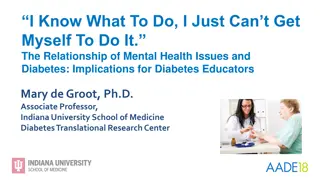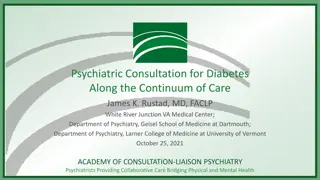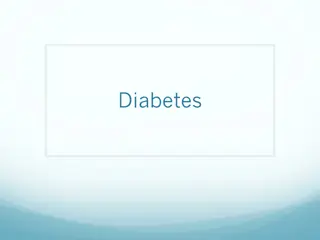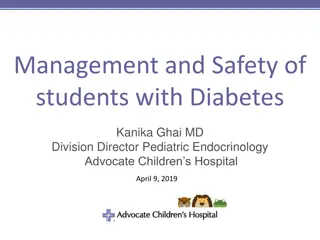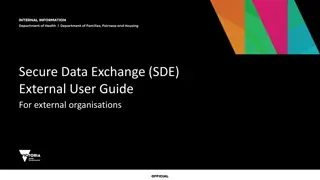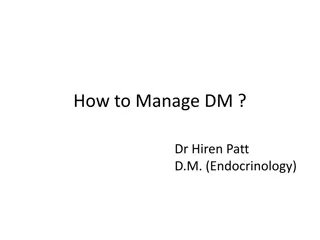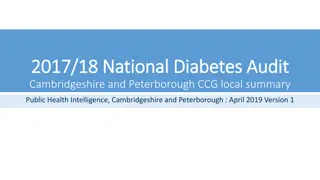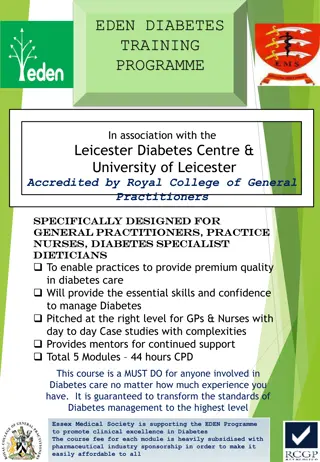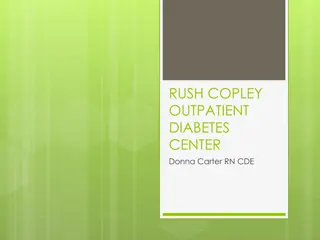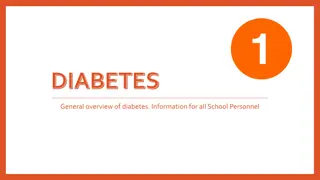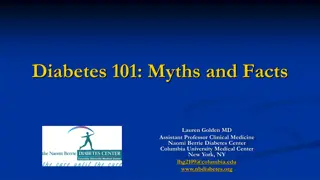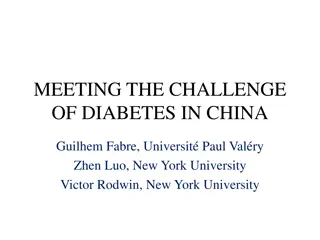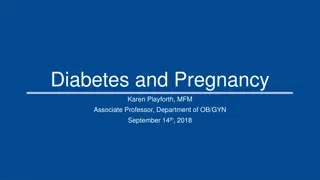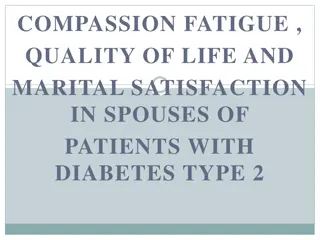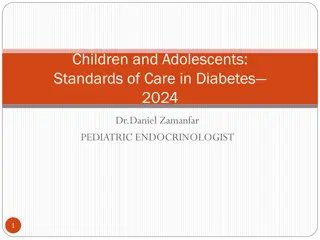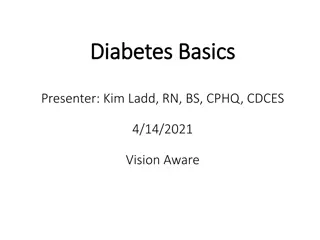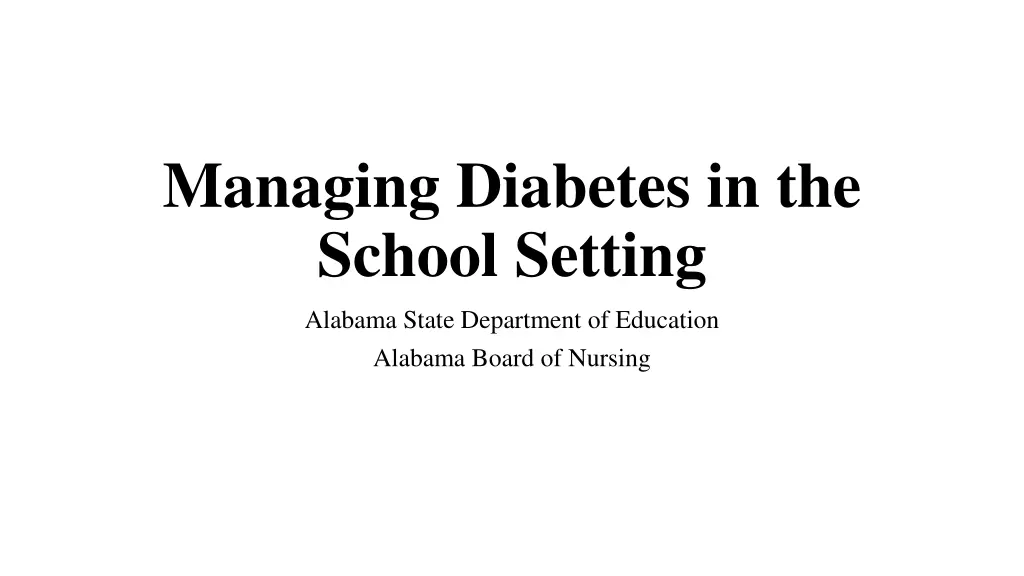
Managing Diabetes in School: Types, Symptoms, and Treatment
Learn about managing diabetes in the school setting, including Type I and Type II diabetes, symptoms, treatments, and how to handle hypoglycemia emergencies. Get insights on blood glucose monitoring, insulin administration, diet management, and prevention strategies for students with diabetes.
Download Presentation

Please find below an Image/Link to download the presentation.
The content on the website is provided AS IS for your information and personal use only. It may not be sold, licensed, or shared on other websites without obtaining consent from the author. If you encounter any issues during the download, it is possible that the publisher has removed the file from their server.
You are allowed to download the files provided on this website for personal or commercial use, subject to the condition that they are used lawfully. All files are the property of their respective owners.
The content on the website is provided AS IS for your information and personal use only. It may not be sold, licensed, or shared on other websites without obtaining consent from the author.
E N D
Presentation Transcript
Managing Diabetes in the School Setting Alabama State Department of Education Alabama Board of Nursing
Diabetes Mellitus: Type I Diabetes Previously called Insulin-dependent or Juvenile Onset Diabetes Pancreas does not make enough insulin (a hormone secreted by the pancreas) If the body has too little or no insulin then glucose cannot enter the cells of the body to be used for energy Symptoms include: Fatigue Increased thirst Frequent urination Treatment includes: Blood glucose monitoring Administration of long and/or rapid-acting insulin Diet, exercise and rest
Diabetes Mellitus: Type II Diabetes Previously called Adult Onset Diabetes Insulin resistance Decreased ability of insulin (a hormone secreted by the pancreas) to move glucose (blood sugar) from our bloodstream into our cells. Risk factors include: Family history Lifestyle choices (diet, exercise, obesity) Treatment includes: Blood glucose monitoring Diet management and exercise Oral medications (Glucophage, Actos, etc.) Insulin
Hypoglycemia (Low blood sugar) Blood glucose less than or equal to 80 mg/dl OR symptoms Usual symptoms of hypoglycemia: Shaky or jittery Sweaty Hungry Pale Headache Blurry vision Sleepy Dizzy
Hypoglycemia: Treatment Can occur very quickly Must be treated immediately Prevention: Regular blood sugar monitoring/in classroom if necessary Meals/Snacks eaten on regular schedule/not skipped/in classroom if necessary Treatment of hypoglycemia: If student is able to swallow and follow directions, treat with a fast-acting carbohydrate (CHO) source. Mini box of juice 8 oz. carton low or no-fat milk can soda (sweetened) 3-4 glucose tablets Remain with student until he/she is able to safely resume normal activity.
Hypoglycemia: Emergency If student becomes unconscious: EMERGENCY Student will be unable to swallow and follow directions Turn student onto his/her side Remain with the student until the on-site School Nurse/Trained Unlicensed Diabetic Assistant arrives OR until EMS arrives If no School Nurse of Trained Unlicensed Diabetic Assistant available - CALL 9-1-1 Treatment of EMERGENT hypoglycemia: Administer Glucagon injection (if ordered by physician) Glucagon is a hormone that when injected raises the blood sugar quickly Glucagon may only be administered by a School Nurse or a Trained Unlicensed Diabetic Assistant Students must be accompanied by a School Nurse or Unlicensed Diabetic Assistant or Parent if participating on a Field Trip or ExtracurricularActivity
Hyperglycemia (High blood sugar) Blood glucose greater than or equal to 300 mg/dl OR symptoms Usual symptoms of hyperglycemia: Increased thirst, dry mouth Frequent or increased urination Change in appetite, nausea Blurry vision Fatigue
Hyperglycemia: Treatment Slower leading to medical emergency (diabetic ketoacidosis) Occurs when symptoms persist without treatment Prevention: Regular blood sugar monitoring/in classroom if necessary Meals/Snacks eaten on regular schedule/not skipped/in classroom if necessary Insulin/Medications taken on time Exercise on time Treatment of hyperglycemia: If student is able to swallow and follow directions, treat with the following: zero calorie fluid (i.e. water)
Hyperglycemia: Emergency If student becomes unconscious: EMERGENCY Student will be unable to swallow and follow directions Turn student onto his/her side Remain with the student until the on-site School Nurse/Trained Unlicensed Diabetic Assistant arrives OR until EMS arrives If no School Nurse of Trained Unlicensed Diabetic Assistant available - CALL 9-1-1 Treatment of EMERGENT hyperglycemia: School Nurse or a Trained Unlicensed Diabetic Assistant will follow physician orders regarding administration of insulin/medication Students must be accompanied by a School Nurse or Unlicensed Diabetic Assistant or Parent if participating on a Field Trip or ExtracurricularActivity
Important Points If you have any questions regarding any information presented on this power point please address them to your school nurse. After you have reviewed this power point please sign the roster provided by your school nurse.

